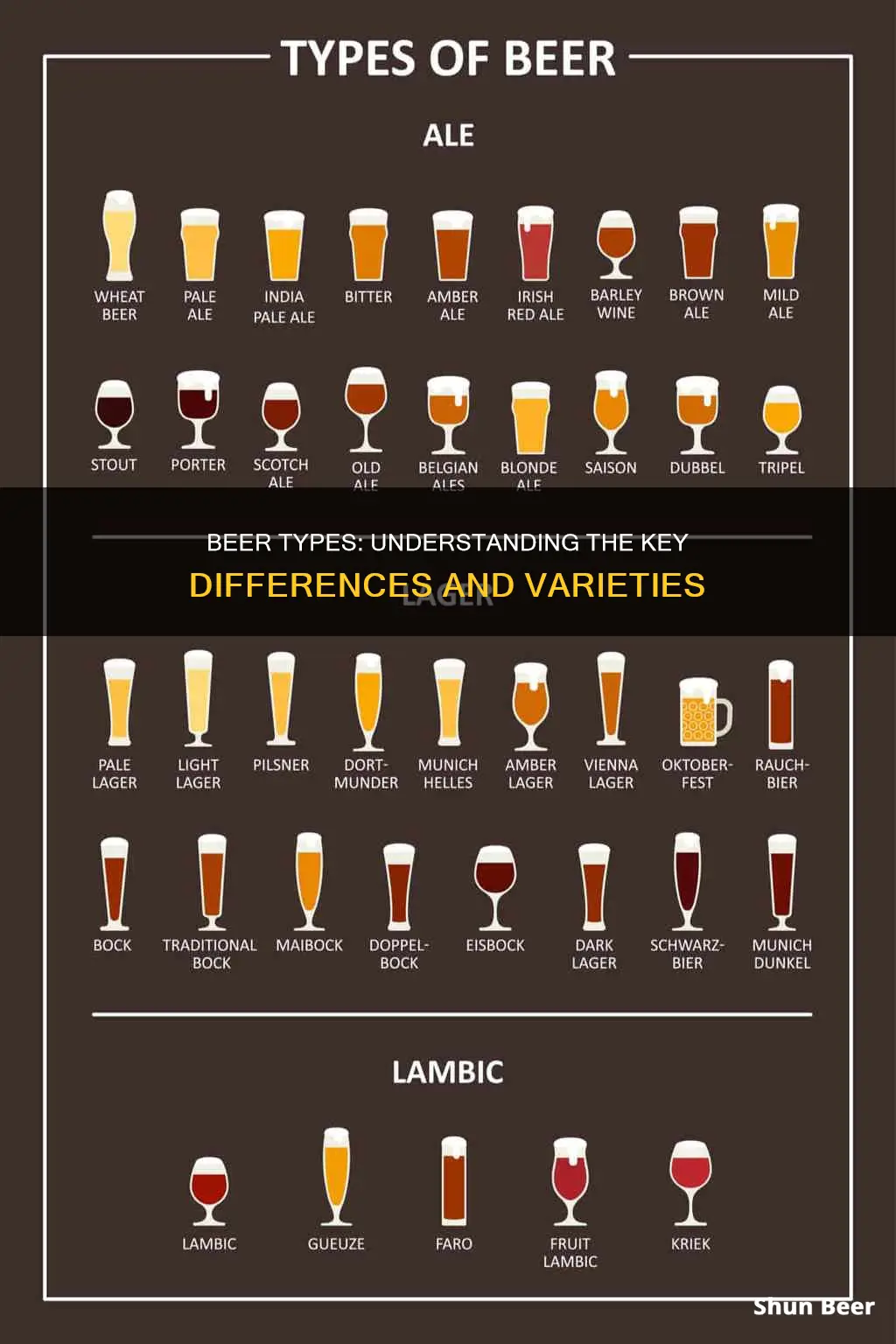
There are two main types of beer: ales and lagers. Ales are brewed at warmer temperatures than lagers, with top-fermenting yeast, and typically between 60-75 degrees Fahrenheit. This results in a faster fermentation process, which imparts a more complex flavor profile that can range from fruity and spicy to bitter and hoppy. Lagers are brewed at cooler temperatures, around 45-55 degrees Fahrenheit, using bottom-fermenting yeast. They have a crisp, clean taste and are known for their smooth and refreshing qualities.
Under the broad category of ales, there are numerous types of beer, including pale ales, India pale ales (IPAs), porters, stouts, and wheat and Belgian styles. Lagers encompass a range of styles, including pale Pilsners and German Helles, and the darker American lagers.
What You'll Learn
- Ales are fermented at warmer temperatures and have a more complex flavour profile
- Lagers are crisp, clean and refreshing, and are fermented at cooler temperatures
- Stouts are dark beers with a robust flavour and creamy mouthfeel
- IPAs are bitter and have high alcohol levels, with a distinct floral, citrus or piney flavour
- Wheat beers are tangy and brewed with a generous amount of wheat

Ales are fermented at warmer temperatures and have a more complex flavour profile
Ales are a specific type of beer that is brewed using a warm fermentation method. Ales are fermented at warmer temperatures, generally between 60 and 75 degrees Fahrenheit (15 to 24 degrees Celsius). This is in contrast to lagers, which are fermented at cooler temperatures, typically around 45 to 55 degrees Fahrenheit.
The warmer fermentation temperature of ales contributes to their more complex flavour profile. Ales tend to have a fruitier taste compared to lagers, with flavours ranging from fruity and spicy to bitter and hoppy. The specific flavour of an ale will depend on the type of yeast used, the fermentation temperature, and the presence of other ingredients.
Ales are brewed using top-fermenting yeast, which gathers at the top of the fermentation tank. This is in contrast to lagers, which use bottom-fermenting yeast. The top-fermenting yeast used in ales has a higher tolerance for alcohol and prefers warmer temperatures.
The warm fermentation process of ales results in a faster fermentation rate compared to lagers. This rapid fermentation, along with the ease of temperature control, makes ales a common base for craft beers.
Ales have a wide variety of styles, including brown ale, pale ale, India pale ale (IPA), Belgian ale, stout, porter, and wheat beer. Each of these styles has unique characteristics in terms of colour, alcohol content, and flavour profile, but they all share the fruitiness and complexity that are typical of ales.
Beer vs Shandy: Understanding the Core Differences
You may want to see also

Lagers are crisp, clean and refreshing, and are fermented at cooler temperatures
Lagers are crisp, clean, and refreshing, and are typically fermented at cooler temperatures than ales, which are often fruity and aromatic. Lagers are usually brewed at temperatures of around 45-55°F (7-13°C), although some sources suggest that lager fermentation can begin at temperatures as low as 32-40°F (0-4°C). Fermenting at these cooler temperatures gives lagers their characteristic smooth and refreshing qualities, making them popular choices for easy-drinking beers, particularly in the summer.
Lagers are typically fermented for longer than ales and use bottom-fermenting yeast, which settles at the bottom of the beer. This yeast has a lower tolerance for alcohol than the yeast used in ales. The longer fermentation process and cooler temperatures allow lagers to develop their crisp, clean, and refreshing qualities.
Lagers are often considered a typical entry point into the world of beer for new drinkers due to their light and slightly malty taste. Classic American lagers include Miller High Life, Coors, Budweiser, and Yuengling. Lagers are also the most popular beer style globally, with Budweiser, Coors Light, Corona, and Michelob Ultra all being well-known lager brands.
While lagers are typically associated with cooler fermentation temperatures, it is worth noting that some lager styles, such as Kölsch, are fermented at warmer temperatures, closer to those used for ales. Additionally, some brewers experiment with open fermentation for lagers, allowing the yeast to be exposed to more oxygen, which can result in a happier and healthier yeast culture.
Explore the Diverse World of IPA Beers
You may want to see also

Stouts are dark beers with a robust flavour and creamy mouthfeel
Stouts are dark beers with a robust flavour and a creamy mouthfeel. They are known for their distinctive colour and smooth finish. Stouts originated in the United Kingdom and have gained worldwide popularity. They are typically associated with Irish dry stouts, such as Guinness, which is characterised by its cascading effect in the glass and dry, roasted malt flavours with hints of coffee and chocolate.
Stouts are typically brewed with roasted barley, which imparts chocolate or coffee flavours. They can also be aged in bourbon or other wooden barrels to develop deeper, boozier characteristics. The flavour profile of stouts ranges from sweet and creamy to bold and intense.
Oatmeal stouts, for example, are brewed with oats, contributing to a smooth and silky mouthfeel. They have a rich, full-bodied flavour with notes of roasted coffee, chocolate, and sometimes a hint of sweetness. On the other hand, imperial stouts are bolder and more intense, with higher alcohol content, rich malt flavours, and complex aromas. They often feature notes of dark fruits, roasted coffee, and bittersweet chocolate.
Stouts are versatile, ranging from cosy 10% ABV imperial stouts to easy-drinking 5% ABV Irish stouts. They pair well with a variety of foods, from hearty dishes like roasted meats and stews to rich desserts.
Stout vs Ale Beer: Understanding the Key Differences
You may want to see also

IPAs are bitter and have high alcohol levels, with a distinct floral, citrus or piney flavour
IPAs, or India Pale Ales, are a popular style of beer known for their bold and bitter hoppy flavours and aromas. They have a distinct flavour profile that can include floral, citrus, or piney notes. The bitterness in IPAs comes from the hops used during brewing, which can also lend herbal, tropical fruit, pine, and berry flavours to the beer.
IPAs are characterised by their high alcohol content and strong malt backbone, which creates a harmonious blend of flavours that appeals to many beer enthusiasts. The alcohol content and bitterness of IPAs can vary depending on the variety of hops used and the brewing techniques employed. For example, New England-style IPAs are known for their lower bitterness and hazy appearance, while West Coast IPAs tend to be more bitter.
The origin of IPAs can be traced back to England in the 19th century, and they have since evolved into various subcategories, including American IPAs, Imperial or Double IPAs, and New England IPAs. American IPAs tend to have a higher alcohol content and more pronounced bitterness, while New England IPAs are known for their hazy appearance and creamy mouthfeel. Imperial or Double IPAs have an even higher alcohol content and increased hop additions, resulting in a more robust and complex flavour profile.
IPAs are often recommended for those looking for a bold and flavourful drinking experience. The intense flavours and aromas of IPAs make them a popular choice for craft beer aficionados. The variety of styles and flavour profiles available within the IPA category offers something for every palate.
Discovering Beer's Flavor Profile: A Guide to Taste
You may want to see also

Wheat beers are tangy and brewed with a generous amount of wheat
Wheat beers are a popular style of beer with a tangy flavour and a generous amount of wheat in the brewing process. Wheat beers are top-fermented and brewed with a large proportion of wheat relative to the amount of malted barley. This gives the beer its distinctive refreshing and crisp taste. Wheat beers are typically lighter in colour and appearance than beers brewed with barley exclusively.
There are different styles of wheat beer, including American wheat beer, German hefeweizen, and Belgian witbier. Witbiers are often brewed with spices such as coriander and orange peel, while hefeweizens frequently have a yeasty character with notes of banana. American wheat beers are typically hoppier than their German counterparts and do not offer flavours of banana or clove.
Wheat beers are very versatile and can be combined with a variety of ingredients, such as seasonal fruits, or enjoyed on their own. They pair well with lighter foods like salads, shellfish, and fresh cheeses. Wheat beers are also often served with a slice of lemon or orange, a custom that originated in Portland, Oregon, in the mid-1980s.
Wheat beers have a light and citrusy profile, making them perfect for cooking seafood or incorporating into salad dressings. They have a bright and refreshing taste that can add a subtle tanginess to dishes.
Overall, wheat beers offer a unique flavour profile that sets them apart from other types of beer, making them a popular choice for those looking for a refreshing and approachable beer.
Pronouncing Beer and Bear: How to Avoid a Slip of the Tongue
You may want to see also
Frequently asked questions
Ales are brewed at warmer temperatures than lagers, with top-fermenting yeast, typically between 60-75 degrees Fahrenheit. Lagers are brewed at cooler temperatures, around 45-55 degrees Fahrenheit, using bottom-fermenting yeast.
Some popular ales include IPAs, pale ales, porters, stouts, and wheat beers.
Some popular lagers include pilsners, German helles, and American lagers.
Ales tend to have a more complex flavor profile, ranging from fruity and spicy to bitter and hoppy. Lagers are known for their crisp, clean, and refreshing taste.







